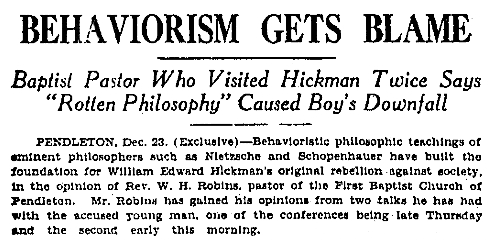January 23, 1927
Los Angeles

Following up yesterday’s story about whether one Ray McCoy was lynched for looking too much like Edward Hickman…
The verdict of the Coroner’s jury? Jail officials and other prisoners, all vindicated. Nevertheless, it seems that Ralph “Ray McCoy” Fuller raised the ire of Angelenos in the grip of Hickman fever, whose Hickmanmania (Hickmania? Hickmentia?) led an angry mob to chase down and beat Fuller something fierce, believing the twenty year-old to be Hickman, after Fuller robbed a store at 242 South Main and was chased two blocks on foot.
Fellow prisoner Fred Meadows told the Times that once in the hoosegow, the sullen and reserved Fuller was regarded as just another popped burglar. Meadows related how he and the boys started playing “Sundown” in an outer tank and when he returned, Fuller had hanged himself with Meadows’ scarf. (Must be nice to have scarves. And pianos.)
In other lynching news, any and all information regarding Hickman’s departure and route from Pendleton (where he was exhibited in a cage like a circus animal) to Los Angeles County Jail is being kept under strict secrecy.







